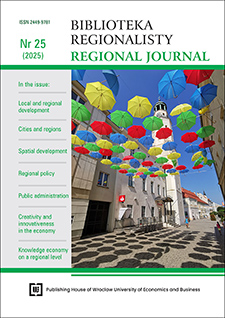The City in New Realities with Particular Emphasis on Safety
DOI:
https://doi.org/10.15611/br.2025.1.10Keywords:
security, city, developmentAbstract
The multi-faceted, heterogeneous, and frequently ideological processes are involved in making the connection between spatial planning and security. The primary reason for the challenges in drawing conclusions from research is the rapid pace of economic transformation, which leads to the accumulation of unforeseen dangers. The use of artificial intelligence (AI) capabilities and the internet, or creative urban monitoring technologies that, on the one hand, aim to increase functionality in terms of security enhancement and, on the other hand, infringe on civil liberties, may serve as an example. Regardless of the debate among academics and practitioners, it is evident that maintaining a high degree of security is a key driver of socioeconomic development. In the current socio-economic environment, this is particularly significant since the burden falls on major cities, and demographic projections indicate that the magnitude and intensity of the risks may increase, at least in comparison to ongoing urbanization trends. In light of these circumstances, the role of security geography in major urban centers seems to be a fascinating topic to study, particularly in terms of quality of life and figuring out the degree to which different parts of the city are criminalized. The purpose of this paper is to demonstrate the criminological phenomena associated with the growth of urban centers, especially in the context of the formation of urbanization processes. The approach used to accomplish this objective, as stated, was mostly descriptive, taking into account the circumstances under which security is provided, but also incorporating aspects of public statistics. The authors highlight the urgent need for ongoing surveillance of risks that not only define crime in the traditional sense but also, and more importantly, call attention to novel occurrences that are a result of the broad openness of major urban centers. The article's cognitive value lies primarily in recognizing the changing social and economic realities that are influencing the growth of major cities.
Downloads
References
Dukała, K. (2012). CPTED – założenia, strategie, sposoby prezentacji. W: J. Czapska (red.), Zapobieganie przestępczości przez kształtowanie przestrzeni (s. 30-43). Wydawnictwo Uniwersytetu Jagiellońskiego.
Głowacki, R., Łojek, K. i Urban, A. (2008). Wpływ ukształtowania przestrzeni fizycznej na zapobieganie przestępstwom i wykroczeniom. Wyższa Szkoła Policji w Szczytnie.
Korenik, A. (2019). Smart Cities, Inteligentne miasta w Europie i Azji. CeDeWu.
Korenik, S. (2010). Współczesne koncepcje przestrzennego rozwoju gospodarki i społeczeństwa. Wydawnictwo Uniwersytetu Ekonomicznego we Wrocławiu.
Kozak, A. (2022). Wybrane obszary funkcjonowania miast w nowych realiach społeczno-gospodarczych. Wydawnictwo Uniwersytetu Ekonomicznego we Wrocławiu.
Łuczyszyn, A. (2017). Miasta jako miejsca kumulacji przestępczości. Prace Naukowe Uniwersytetu Ekonomicznego we Wrocławiu, (490), 209-218.
Łuczyszyn, A. i Łuczyszyn, M. (2018). Urbanizacja jako element rozwoju miasta. Prace Naukowe Uniwersytetu Ekonomicznego we Wrocławiu, (502), 53-61.
Łuczyszyn, A. i Łuczyszyn, T. (2020). Zapewnianie bezpieczeństwa jako otwartość zarządzania publicznego i czynnik rozwoju lokalnego w warunkach globalizacji. W: B. Wiśniewska-Paź (red.), Jedność w różnorodności. Społeczeństwo otwarte a bezpieczeństwo. Konteksty Szwajcarskie (s. 41). Wydawnictwo Adam Marszałek.
Łuczyszyn, T. (2020). Bezpieczeństwo jako element jakości życia w mieście. W: A. Zakrzewska-Półtorak (red.), Nowe oblicza miast. Debiuty Studenckie 2020 (s. 36-51). Wydawnictwo Uniwersytetu Ekonomicznego we Wrocławiu.
Sypion-Dutkowska, N. (2014). Uwarunkowania przestrzenne przestępczości w wielkim mieście w ujęciu GIS (na przykładzie Szczecina). Studia komitetu przestrzennego zagospodarowania kraju PAN, (159), 5-122.
Szymańska, D. (2008). Urbanizacja na świecie. Wydawnictwo Naukowe PWN.
Świętochowska, U. (2001). Patologie cywilizacji współczesnej. Wydawnictwo Adam Marszałek.
Downloads
Published
Issue
Section
License
Copyright (c) 2025 Andrzej Łuczyszyn, Patrycja Papież

This work is licensed under a Creative Commons Attribution-ShareAlike 4.0 International License.
Accepted 2025-04-02
Published 2025-06-27







